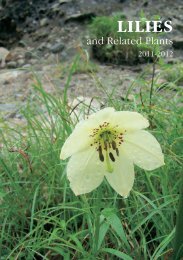LILIES - RHS Lily Group
LILIES - RHS Lily Group
LILIES - RHS Lily Group
Create successful ePaper yourself
Turn your PDF publications into a flip-book with our unique Google optimized e-Paper software.
somewhat decadent, in that we parked beside or nearby lilies and with the<br />
minimum of physical effort observed them, photographed them and then drove<br />
on to the next location. Although it was very convenient that most of the lilies<br />
we found were growing by the roadside, I couldn’t help but wonder at their<br />
possible incidence and distribution away from the roadside. Starting from a<br />
group of roadside lilies, it would have been interesting to have organised a posse<br />
of hill-walking lily chasers and had them fan out over a few kilometres with the<br />
objective of recording the location of any lilies they found, to be discussed when<br />
the posse met at an agreed point on the map. This information could then have<br />
been transcribed into an excellent and informative article for NALS members with<br />
an interest in indigenous species lilies. Later, when I put this suggestion to David<br />
Sims at the NALS Convention, he said he thought it should be done as both the<br />
activity and the results could be very interesting.<br />
Another lily-related topic I discussed with David and Charlie was the concept<br />
of maintaining national collections of plants. David had previously informed me<br />
that he was an admirer of the concept, so I questioned him as to why there is<br />
no national collection of American species lilies, as this could raise the profile of<br />
these beautiful and diverse plants and, concomitantly, the desirability of growing,<br />
the two dozen or so, indigenous lilies. I also asked Charlie for his views on this<br />
matter. Their answers seemed to highlight a difference in gardening tradition<br />
between the UK and the USA, where the former country seems to have favoured<br />
the concept of national collections more than the latter. Both David and Charlie<br />
also pointed to the preference for hybrids among American lily growers, as these<br />
are easier to deal with and more adaptable, to the climatic variations across the<br />
states, than are indigenous species. However, I was left wondering if, with interest<br />
and motivation, it would really be beyond the bounds of possibility to locate a<br />
garden(s), in a more or less temperate state(s), that could be landscaped into<br />
environments to approximate to the requirements for dry and wetland lilies? I have<br />
to admit to a selfish motive, in promoting the development of a national collection<br />
of this nature, as the interest I hope it would generate might lead US lily nurseries<br />
to stock all of the indigenous species – not just L. pardalinum and L. superbum<br />
– whereby I could add to the 11 American species I grow currently.<br />
Time marches on inexorably and it is now almost four months since I said<br />
goodbye to Charlie, Barb, Kathy and David at the end of the NALS Convention<br />
in Edmonton. Although, as indicated in the second paragraph of this article, I<br />
had met Charlie at the <strong>RHS</strong> <strong>Lily</strong> Conference in 2004, I had not met Barb or Kathy<br />
before we arrived at Barb’s house in Reno. Yet, we all got on well with each<br />
other, so as the American’s say “how come”? I’m not sure what the answer is,<br />
but perhaps it’s a tribute to our shared interest in the lovely quarry of our chase<br />
– the lily. Or, perhaps lilies just make nicer people of us all.<br />
79




